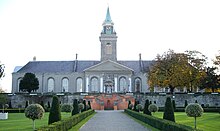Irish Museum of Modern Art
The Irish Museum of Modern Art, also known as IMMA, opened in May 1991 and is Ireland's leading national institution exhibiting and collecting modern and contemporary art. It is located in the Royal Hospital, Kilmainham, a fine 17th-century building near Heuston Station to the west of Dublin's city centre. The current director is Enrique Juncosa, he was previously Deputy Director of the Reina Sofia National Museum Arts Centre (MNCARS) in Madrid. Juncosa is only the second director of the IMMA, the first was Declan McGonagle.

The Museum concentrates on acquiring contemporary art by living artist and buys only from primary markets: studios and galleries. It also accepts donations of art dating from 1940 onwards and through some generous gifts has made progress towards a representative collection of art of that period. Given its youth the museum has a reasonable collection and it mounts selective exhibitions of its own collection. It concentrates on hosting exhibitions and has a very active exhibition programme as demonstrated by the example of the exhibition programme for 2003 given below. It is hoped that in the future the Museum will be provided with more space, allowing its current activity to be complimented by an encyclopedic permanent display of contemporary art, something Ireland lacks.

The Royal Hospital is a striking location for displaying modern art. Modelled on Les Invalides in Paris, it is arranged around a courtyard and the interior has long corridors running along series of modest interlocking rooms. This has made for some interesting and visually exciting exhibits, but the museum is limited it its ability to house large works of art. Another disadvantage is that it is difficult to move art works around. However, in its favour, the layout allows several exhibitions to run concurrently and the setting is very fine: the courtyard, the noble facades, a restored baroque formal garden and a lovely old dining room and chapel. The dining room generates income as a venue for weddings and conference dinners, as does the cafe and bookshop in the vaults; the Museum itself is free.
The original stables of the Royal Hospital have been restored, extended and converted into artists studios and the Museum runs an artist in residence programme. The Museum also has community and education programmes and a national programme whereby it exhibits works from its collection in other venues.
Exhibitions in 2003
- Langlands and Bell: The House of Osama bin Laden
- Louise Bourgeois: Stitches in Time
- Private and Public Narratives: Selected works from the IMMA Collection
- Living in Motion: Design and Architecture for Flexible Dwelling
- Knut Åsdam
- Paul Seawright: Hidden
- Paul Morrison: haematoxylon
- Cristina Iglesias
- COBRA: Copenhagen Brussels Amsterdam
- The Tail that Wags the Dog: Outsider Art in the Expressionist Tradition
- Weltkunst Collection: Glad that things don't talk
- Rose Finn-Kelcey: Bureau de Change
- Gary Hume
- Recent Acquisitions to the IMMA Collection
- Lorna Simpson: Photoworks and Films 1986 - 2002
- John the Painter
